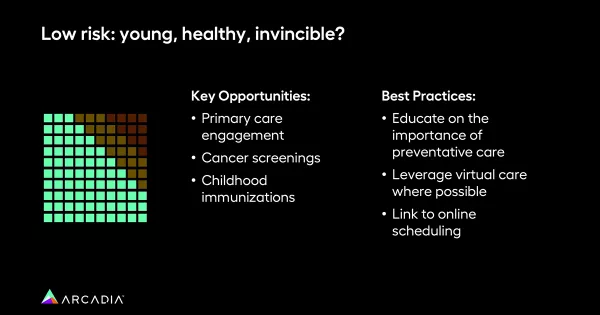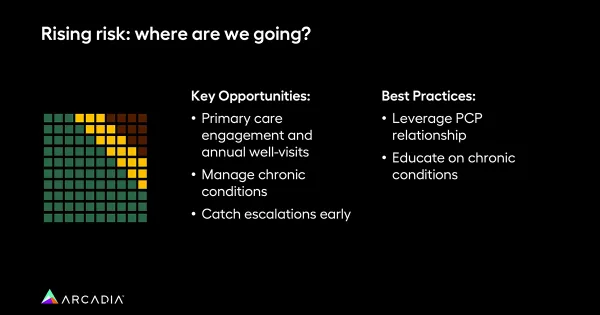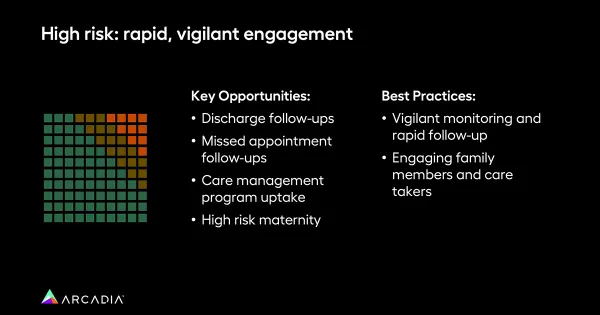How to harness analytics for data-driven value-based care
According to the AMA Center for Health Equity, 73% of payers are shifting to a value-based care (VBC) payment model. As the healthcare industry increasingly adopts this model, providers must place more emphasis on understanding patients’ unique care needs and improving their outcomes.
This shift highlights the need for data-driven value-based care — the process of applying data insights to help providers thrive under VBC payment models. This article explores the power of data-driven approaches to bridging the gaps in patient care.
What does data-driven value-based care mean?
Under value-based care contracts, payers or government entities compensate providers based on improvements in the member population’s overall health. To make decisions that improve patient outcomes, enhance care quality, and reduce costs, providers rely on data.
In other words, a data-driven approach to value-based care involves using analytics tools to extract insights from health data and apply those insights through patient outreach and proactive interventions.
Key aspects of this process include:
- Data integration: Health systems must be prepared to integrate data from various sources, including electronic health records (EHRs), claims data, social determinants of health (SDoH), and more, to access a comprehensive view of patient health
- Predictive analytics: Providers can use data to predict health risks and intervene early, preventing adverse health events and the costs associated with them
- Performance measurement: Key outcome metrics like patient satisfaction, cost efficiency, and readmission rates can signal a health organization’s performance under a value-based care payment model
Data is vital for every step of the value-based care process, which is why health organizations must equip their teams with analytics tools and techniques that can return results.
How to utilize analytics for data-driven value-based care
1. Implement analytics tools
Analytics tools enable health organizations to consolidate, organize, and extract insights from critical data. As such, implementing these tools should be the first step in your data-driven approach to value-based care.
These tools are responsible for:
- Data integration
- Identifying key metrics
- Visualizing data through intuitive dashboards
- Stratifying risk
- Delivering real-time insights for decision-making
Arcadia’s value-based care software aggregates VBC data into a single platform, analyzes trends, surfaces opportunities, and automates tedious processes so teams across the care continuum can act on relevant insights. The result? Health teams can reap the benefits of a data-driven approach to healthcare delivery.
2. Understand the population
To effectively engage patients, healthcare organizations must first understand the populations they serve. Stratification is a crucial step in this process. As Anna Basevich emphasizes in Arcadia’s Byte-Sized Booth Talk at HIMSS, merely dividing patients into low-risk, rising-risk, and high-risk cohorts is not enough. Each cohort comprises individuals with unique needs and contexts. The key is to dive deeper and create more tailored groups within these cohorts.
Low-risk
The low-risk population typically consists of young and relatively healthy individuals who may not see immediate value in routine primary care. However, it is essential to educate them about the significance of preventative care and regular check-ups. For instance, when reminding patients about cancer screenings, it is essential to address their age-specific needs to increase response rates.

Since the low-risk population is generally more tech-savvy, healthcare providers can leverage technology to engage them effectively. Utilizing platforms like MyChart for virtual visits and appointment scheduling can make healthcare more accessible and convenient for these patients.
Rising-risk
The rising-risk population includes patients with early-stage chronic diseases or specific healthcare challenges. To engage this group, healthcare providers must tailor their communication to each patient's condition. This could involve providing evidence-based guidelines and emphasizing the value of primary care for managing chronic conditions.

Additionally, identifying barriers to care is crucial for this population. Leveraging data to understand preferred contact languages, transportation challenges, or affordability concerns can help providers remove obstacles to care and improve patient engagement.
High-risk
The high-risk population requires vigilant engagement to ensure they do not miss essential follow-ups and care. Personalized, rapid outreach is vital in this scenario. Healthcare providers should use technology to schedule follow-up visits, send educational materials, and offer support through care management programs. Engaging family members can also be beneficial in coordinating care and ensuring patients receive the necessary attention across their care continuum.

3. Optimize patient outreach
Data-driven value-based care informs effective patient engagement and outreach, helping healthcare providers identify patients who can benefit from specific outreach efforts. Analytics can also help address social determinants of health (SDoH) and behavioral health challenges.
Basevich offers the following best practices for healthcare organizations looking to implement data-driven patient outreach strategies:
- Leverage data for stratification. Use data to identify actionable cohorts of patients for targeted messaging and engagement
- Tailor communication. Ensure patient outreach resonates with individuals by personalizing messages based on their conditions and preferences
- Understand barriers to care. Collaborate with care managers and social health workers to identify patient concerns and address potential obstacles to care
- Empower providers. While data is essential, it should never replace genuine human conversation. Providers should use data as a tool to inform and complement their understanding of patients' unique needs and experiences
- Prioritize consistency and speed. Consistent, timely patient follow-up can make a significant difference in patient outcomes, especially for high-risk populations
Specific use cases include:
- Behavioral health impact scores: Build behavioral health impact scores for patients with chronic conditions and behavioral health challenges. These scores help identify patients who could benefit from behavioral health interventions to improve both their behavioral health and traditional medical outcomes.
- Addressing social drivers of health: Leverage data to create registries around social drivers of health, such as language barriers, transportation challenges, or affordability issues. Understanding and addressing these factors in patient messaging can break through barriers to care and foster patient engagement.
- High-risk maternity registries: For high-risk maternity patients, data can be used to identify opportunities for early engagement and consistent support. Leveraging EHR data and monitoring patients' health status can help healthcare providers intervene promptly and improve maternal and infant outcomes.
Access value-based care analytics to fuel a data-driven approach
Data-driven approaches hold immense potential for improving patient engagement and care outcomes. By using data to stratify populations, plan interventions, and tailor patient messaging, healthcare providers can bridge the gaps in care delivery.
However, it is essential to remember that data is a tool to enhance, not replace, human connection and empathy in healthcare. By combining data insights with genuine understanding and support, healthcare organizations can create meaningful patient engagement that leads to better health outcomes for all.
